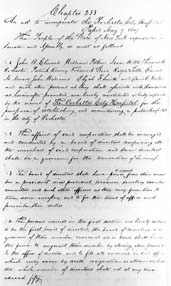 In the 1820s, Rochester's mortality rate was high; nearly three out of every 100 people died of disease each year, and almost half the deaths were children under three years old. The patient’s family met early community healthcare needs; treatment was in the home, and if the family was too poor the city physician was called to attend the sick.
In the 1820s, Rochester's mortality rate was high; nearly three out of every 100 people died of disease each year, and almost half the deaths were children under three years old. The patient’s family met early community healthcare needs; treatment was in the home, and if the family was too poor the city physician was called to attend the sick.
In 1822 a concerned group of women, the Rochester Female Charitable Society, began visiting the poor and sick.
They divided the city into districts with each member responsible for the poor in her district. Financed by dues and church collections, they saw to the needs of their charges, be it clothing, food, shelter, medical care or jobs. Recognizing the need to establish a hospital, the Society formed a hospital committee in 1845 and began a grass-roots movement that would culminate in the formation of the Rochester City Hospital.
Meanwhile a group of community leaders working independently applied to the New York State Legislature for a charter to incorporate a hospital. The State granted a charter for Rochester City Hospital on May 7, 1847. Though it was now an official entity, the Hospital still had no site or money. For the next 17 years the Charitable Society and the Chartering Board battled public apprehension and indifference.
On Christmas Day 1851 the Rochester Common Council turned over the Western Cemetery lot on West Main Street to the Incorporators to use as the future hospital site. The cemetery was in disrepair, and pigs wandered among the gravestones. Many of the burials had already been moved to the newer Mount Hope Cemetery. The cemetery lot was given with the proviso that the Incorporators would maintain the property until the remaining burials could be moved to another location.
In the meantime, the Female Charitable Society continued their work with the poor. In 1849 they established the Home for the Friendless, today's Friendly Home. Never losing sight of their goal of establishing a hospital, the Charitable Society rented a room at the Home for care of the sick. In February 1857 they set up a hospital in a house on North Street. The Charitable Society hired a matron who cared for at least one patient, but the project was abandoned four months later as being too expensive.

By 1860, the Western Cemetery had been cleared of most of the burials; and the first hospital building had been started. In 1862 the Rochester City Hospital building was completed at a cost of $14,277.90. However, the institution was $4,000 in debt, and without money for furnishings, the building could not open.
In 1862 the Board of Directors offered the newly completed City Hospital facilities to the Federal Government as a military hospital. The offer was declined. The building lay vacant for two years. Meanwhile St. Mary's Hospital was named a "U.S. Army General Hospital" in March of 1863.
Subsequently, in 1863, the Incorporators entrusted the management of the Hospital to the Female Charitable Society, who had furnished the Hospital through a number of ambitious and successful charity events including a bazaar that raised $10,000.
